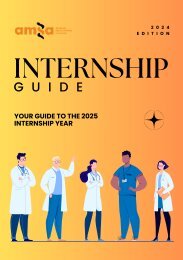Vector Volume 11 Issue 2 - 2017
Create successful ePaper yourself
Turn your PDF publications into a flip-book with our unique Google optimized e-Paper software.
as well as facilitating educated discussion about the<br />
possibilities of chromosomal abnormalities or multifetal<br />
gestation, would also mitigate conflict. Antenatal and<br />
postnatal support, including mental health checks, could<br />
also be provided through this system.<br />
The exclusion of profiting intermediaries increases the<br />
likelihood that the interests of all parties would be equally<br />
considered, rather than sacrificing the surrogate’s health<br />
and experience in favour of maximising profits. Moreover,<br />
any surrogacy arrangements would still be constrained<br />
by Australia’s existing common law and family law. This<br />
ensures that the surrogate maintains all the decisionmaking<br />
powers throughout the pregnancy, including her<br />
rights to access termination of pregnancy and to bodily<br />
autonomy.<br />
In terms of the appropriate compensation, it seems<br />
prudent to set both a minimum and a maximum limit.<br />
Pregnancy is unavoidably risky for a woman, and gestating<br />
a growing fetus is no easy task. Why should it not, like<br />
many other jobs, receive recompense proportionate to<br />
the task? Moreover, pregnancy is intrinsically care-based<br />
‘women’s work’, which is still insidiously undervalued<br />
even in modern times. Conversely, to titrate the price of<br />
surrogacy to the intensity of a commissioning couple’s<br />
desire for a child is hardly ethical. The US can shed light<br />
on what prices may look like in an uncapped surrogacy<br />
market; the estimated reimbursement for surrogates<br />
advertised by leading US agency Circle Surrogacy, not<br />
including medical or otherwise associated expenses,<br />
is US$30,000.[18] Most couples experiencing infertility<br />
would struggle to pay this price, which does not include<br />
medical and legal costs. The aim of setting both minimum<br />
and maximum limits on a surrogate’s compensation is to<br />
strike a balance between the interests of the surrogate<br />
and the commissioning parents - or more simply put,<br />
ensuring fair pay for fair work.<br />
Furthermore, a centralised agency would also offer<br />
benefits for children born from surrogacy arrangements.<br />
There would exist a database through which children<br />
could later in life track down their surrogates should<br />
they choose to, just as adopted children can request<br />
information regarding their birth origins after turning 18.<br />
The laws regarding surrogacy should be standardised<br />
across all Australian states and territories. At present, the<br />
laws are fractured and discordant, diverging on points<br />
including whether same-sex couples should be eligible<br />
to be intended parents, the legality of advertisement for<br />
surrogacy, as well as that of seeking overseas surrogates.<br />
The murky legalities of surrogacy make it confusing for<br />
surrogates without deterring commissioning parents; if<br />
they are willing to pay tens of thousands of dollars for<br />
surrogacy, they would probably be happy to travel to<br />
states with more favourable laws.[6]<br />
Challenges of decriminalisation of commercial<br />
surrogacy<br />
One might argue that by decriminalising commercial<br />
surrogacy in Australia, we simply shift the burden of<br />
exploitation from overseas to our own shores. The<br />
concern is that commercial surrogates will be uneducated<br />
and disempowered, and have little informed choice in<br />
the matter. If we assume that the demographic of paid<br />
surrogates in Australia would resemble that of the US,<br />
then this concern does not appear to be relevant.[17, 19]<br />
Small studies of commercial surrogates in the US have<br />
suggested the while surrogates do tend to have lower<br />
incomes and less education than commissioning parents,<br />
they are generally not of a vulnerable population. In one<br />
study, most had gone to college, or at least finished high<br />
13

















